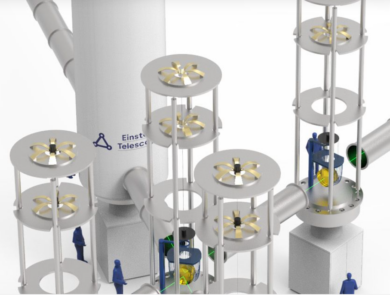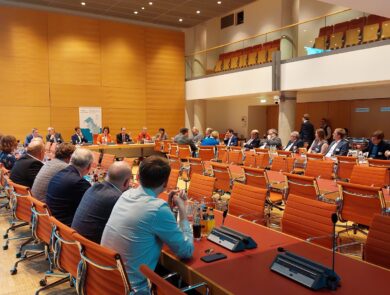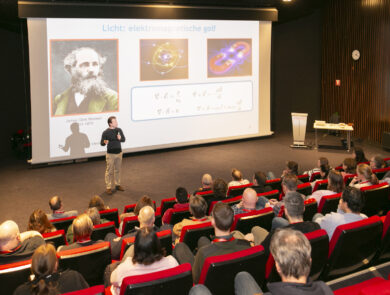Test facility ETpathfinder enters new phase
A progress workshop in February marks the start of a new phase at the international test facility ETpathfinder. In their cleanroom in Maastricht, European scientists and companies are building a realistic mock-up of the vibration-free interferometers that will sit at the heart of the Einstein Telescope.
Where less than 4 years ago diggers were taking out the floor of an old storage space, nowadays you will find a top-of-the-line cleanroom. With six towering vacuum vessels connected by beam pipes, the ETpathfinder facility develops and tests crucial technology for the future Einstein Telescope.
“The initial phase of building the infrastructure is now practically finished”, explains project head Prof Stefan Hild (Maastricht University), who looks forward to integrating technology from across Europe in the first vacuum tower. During their progress workshop in the first week of February, ETpathfinder researchers from participating labs across Europe discussed next steps for the facility.

Staying on the cutting edge
One of the contributors at the workshop was Rafael Garcia from the Spanish institute for high energy physics IFAE. He recalls how his group was asked to help finish the ETpathfinder thermal shields, which in four stages help thermally isolate the mirrors in the innermost part ETpathfinder. Garcia: “These shields protect the mirrors from heat radiation coming from the environment. The design has to take into account also the assembly and accessing to the mirrors, among other manufacturing aspects related with Ultra High Vacuum environments.”
Asked why IFAE decided to get involved in the ETpathfinder, Garcia doesn’t have to think long. “IFAE is part of the Einstein Telescope and is always happy to collaborate with top-level institutions. This is the case of ETpathfinder, probably the most advanced R&D platform for ET in Europe. Personally speaking, it’s a privilege for me having the opportunity to work for such a research facility. It allows me to stay on the cutting edge!”


Extraordinary
The Einstein Telescope is Europe’s planned underground observatory for gravitational waves. These minute wobbles in spacetime occur when black holes or other compact stellar objects collide in the universe. The Einstein Telescope will measure these waves by constantly tracking the length of laser paths between mirrors in its 10-kilometer tunnels.
Reaching the required sensitivity for the Einstein Telescope—ten times better than existing observatories—will take extraordinary measures. Those include vibration-dampening pendulums to insulate the equipment from micro-movements of the earth, a vacuum environment, even cryogenic cooling to quiet vibrations in the mirrors themselves.

Integrated
One example of new tech coming to ETpathfinder is the innovative cooling system which will be developed for ETpathfinder by a consortium of three Dutch companies under a recent R&D grant. And it’s not just companies contributing technological solutions to ETpathfinder.
Only weeks after the progress workshop, a team from the Polish Nicolaus Copernicus Astronomical Center installed a package of seismometers and infrasound detectors in Maastricht, intended to monitor the facility and determine the level of outside noise in order to calibrate the performance of ETpathfinder’s vibration damping towers. Those towers are crucial for the future Einstein Telescope, as they will isolate the observatory’s laser system from outside vibrations.
As an R&D facility, ETpathfinder will not be able to detect gravitational waves itself—the ten-meter arms of its interferometers would need to be 1000 times as long to do that. But as a place to test and integrate technology intended, ETpathfinder already contributes to the success of Europe’s future observatory for gravitational waves, by demonstrating that proposed solutions to technological challenges will work in a realistic environment.


